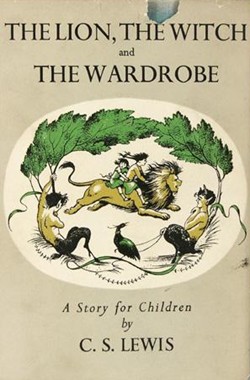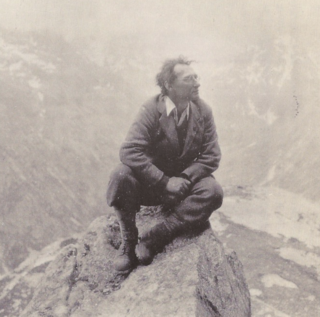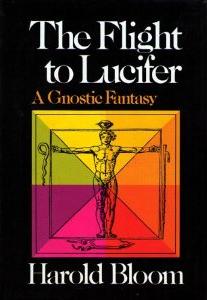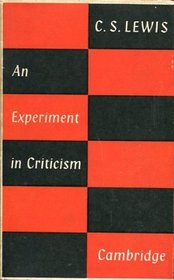
The Lion, the Witch and the Wardrobe is a portal fantasy novel for children by C. S. Lewis, published by Geoffrey Bles in 1950. It is the first published and best known of seven novels in The Chronicles of Narnia (1950–1956). Among all the author's books, it is also the most widely held in libraries. It was the first of The Chronicles of Narnia to be written and published, but is marked as volume two in recent editions that are sequenced according the stories' internal chronology. Like the other Chronicles, it was illustrated by Pauline Baynes, and her work has been retained in many later editions.

Reader-response criticism is a school of literary theory that focuses on the reader and their experience of a literary work, in contrast to other schools and theories that focus attention primarily on the author or the content and form of the work.

Ivor Armstrong Richards CH, known as I. A. Richards, was an English educator, literary critic, poet, and rhetorician. His work contributed to the foundations of the New Criticism, a formalist movement in literary theory which emphasized the close reading of a literary text, especially poetry, in an effort to discover how a work of literature functions as a self-contained and self-referential æsthetic object.
A review is an evaluation of a publication, product, service, or company or a critical take on current affairs in literature, politics or culture. In addition to a critical evaluation, the review's author may assign the work a rating to indicate its relative merit.
Literary fiction, mainstream fiction, non-genre fiction, serious fiction, high literature, artistic literature, and sometimes just literature are labels that, in the book trade, refer to market novels that do not fit neatly into an established genre ; or, otherwise, refer to novels that are character-driven rather than plot-driven, examine the human condition, use language in an experimental or poetic fashion, or are simply considered serious art.

Used colloquially as a noun or adjective, "highbrow" is synonymous with intellectual; as an adjective, it also means elite, and generally carries a connotation of high culture. The term, first recorded in 1875, draws its metonymy from the pseudoscience of phrenology, which teaches that people with large foreheads are more intelligent. The term is deeply connected to hierarchical racial theories from the 19th century. The German physician, physiologist, and anthropologist Johann Friedrich Blumenbach (1752–1840) argued "for human diversity alonglines of racial differences as evidenced by skulls shapes and measurements. [...] One metric of Blumenbachs classification was the line of theforehead, said to be higher among 'Caucasians' and lower among 'Mongolians' and 'Ethiopeans' and this is the origin of the still common usage of 'highbrow' and 'low brow' ".
The term middlebrow describes middlebrow art, which is easily accessible art, usually popular literature, and middlebrow people who use the arts to acquire the social capital of "culture and class" and thus a good reputation. First used in the British satire magazine Punch in 1925, the term middlebrow is the intellectual, intermediary brow between the highbrow and the lowbrow forms of culture; the terms highbrow and lowbrow are borrowed from the pseudoscience of phrenology.

A Reader's Manifesto is a 2002 book by B. R. Myers expanded from his essay in the July/August 2001 issue of The Atlantic Monthly magazine. Myers criticized what he saw as the growing pretentiousness of contemporary American literary fiction, especially in contrast to genre fiction.

The Believer is an American bimonthly magazine of interviews, essays, and reviews, founded by the writers Heidi Julavits, Vendela Vida, and Ed Park in 2003. The magazine is a five-time finalist for the National Magazine Award.

The Flight to Lucifer: A Gnostic Fantasy is a 1979 fantasy novel by American critic Harold Bloom, inspired by his reading of David Lindsay's fantasy novel A Voyage to Arcturus (1920). The plot, which adapts Lindsay's characters and narrative and features themes drawn from Gnosticism, concerns Thomas Perscors, who is transported from Earth to the planet Lucifer by Seth Valentinus.

A Preface to Paradise Lost is one of C. S. Lewis's most famous scholarly works. The book had its genesis in Lewis's Ballard Matthews Lectures, which he delivered at the University College of North Wales in 1941. It discusses the epic poem Paradise Lost, by John Milton.
J. R. R. Tolkien's bestselling fantasy novel The Lord of the Rings had an initial mixed literary reception. Despite some enthusiastic early reviews from supporters such as W. H. Auden, Iris Murdoch, and C. S. Lewis, literary hostility to Tolkien quickly became acute and continued until the start of the 21st century. From 1982, Tolkien scholars such as Tom Shippey and Verlyn Flieger began to roll back the hostility, defending Tolkien, rebutting the critics' attacks and analysing what they saw as good qualities in Tolkien's writing.
Critical reading is a form of language analysis that does not take the given text at face value, but involves a deeper examination of the claims put forth as well as the supporting points and possible counterarguments. The ability to reinterpret and reconstruct for improved clarity and readability is also a component of critical reading. The identification of possible ambiguities and flaws in the author's reasoning, in addition to the ability to address them comprehensively, are essential to this process. Critical reading, much like academic writing, requires the linkage of evidential points to corresponding arguments.

Peter Swirski is a Canadian novelist, scholar, and literary critic featured in Canadian Who's Who. He is the author and editor of 19 nonfictions, including the prize-winning Ars Americana, Ars Politica (2010) and the staple of American popular culture studies From Lowbrow to Nobrow (2005). His other studies include American Utopia and Social Engineering (2011), American Political Fictions (2015), American Utopia: Literature, Society, and the Human Use of Human Beings, and the digital-futurological bestseller From Literature to Biterature (2013). He is also the leading authority on the late writer and philosopher Stanisław Lem.

From Lowbrow to Nobrow is a book on literary culture written by Peter Swirski, professor of American literature and culture at the University of Missouri, St. Louis and Research Director at the Helsinki Collegium for Advanced Studies. Swirski is the author of twelve books of American literature and culture, Stanislaw Lem, and theory of knowledge.
"The Tale of Scrotie McBoogerballs" is the second episode of the fourteenth season of the American animated television series South Park, and the 197th overall episode of the series. It originally aired on Comedy Central in the United States on March 24, 2010. The plot centers upon a prank book manuscript anonymously written by fourth grade classmates Kyle, Stan, Kenny, and Cartman, whose vulgar content nauseates all who read it, but who also laud it as a masterpiece. The prank backfires when classmate Butters, whom the boys convinced is the actual author of the book, is hailed a genius, and the book is analyzed for profound subtext that the boys never intended.
The 3rd Degree is a British quiz show broadcast on BBC Radio 4, hosted by comedian Steve Punt and made by Pozzitive Television. The series is recorded at different universities around the country, the contestants all coming from the university in which the recording takes place. One team consists of three students and the other of three lecturers who teach the subjects the students are studying.

R v Penguin Books Ltd, was the public prosecution in the United Kingdom of Penguin Books under the Obscene Publications Act 1959 for the publication of D. H. Lawrence's 1928 novel Lady Chatterley's Lover. The trial took place over six days, in No 1 court of the Old Bailey, between 20 October and 2 November 1960 with Mervyn Griffith-Jones prosecuting, Gerald Gardiner counsel for the defence and Laurence Byrne presiding. The trial was a test case of the defence of public good provision under section 4 of the Act which was defined as a work "in the interests of science, literature, art or learning, or of other objects of general concern".
Feminist children's literature is the writing of children's literature through a feminist lens. Children's literature and women's literature have many similarities. Both often deal with being seen as weak and placed towards the bottom of a hierarchy. In this way feminist ideas are regularly found in the structure of children's literature. Feminist criticism of children's literature is therefore expected, since it is a type of feminist literature. Feminist children's literature has played a critical role for the feminist movement, especially in the past half century. In her book Feminism Is for Everybody: Passionate Politics, bell hooks states her belief that all types of media, including writing and children's books, need to promote feminist ideals. She argues "Children's literature is one of the most crucial sites for feminist education for critical consciousness precisely because beliefs and identities are still being formed". The cover of hooks' book, drawn by Laura DeSantis, depicts children alongside adults, showing the importance of the youth. The presence of feminism in children's literature has evolved over the years, but the overall message and goals have remained consistent.
In literary criticism and cultural studies, postcritique is the attempt to find new forms of reading and interpretation that go beyond the methods of critique, critical theory, and ideological criticism. Such methods have been characterized as a "hermeneutics of suspicion" by Paul Ricœur and as a "paranoid" or suspicious style of reading by Eve Kosofsky Sedgwick. Proponents of postcritique argue that the interpretive practices associated with these ways of reading are now unlikely to yield useful or even interesting results. As Rita Felski and Elizabeth S. Anker put it in the introduction to Critique and Postcritique, "the intellectual or political payoff of interrogating, demystifying, and defamiliarizing is no longer quite so self-evident." A postcritical reading of a literary text might instead emphasize emotion or affect, or describe various other phenomenological or aesthetic dimensions of the reader's experience. At other times, it might focus on issues of reception, explore philosophical insights gleaned via the process of reading, pose formalist questions of the text, or seek to resolve a "sense of confusion."











